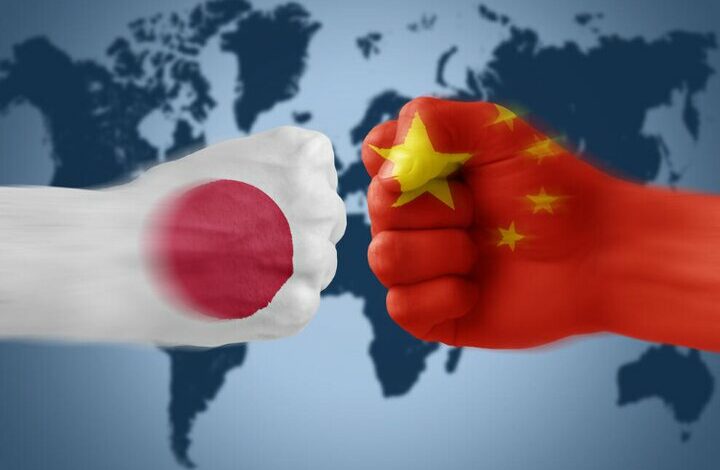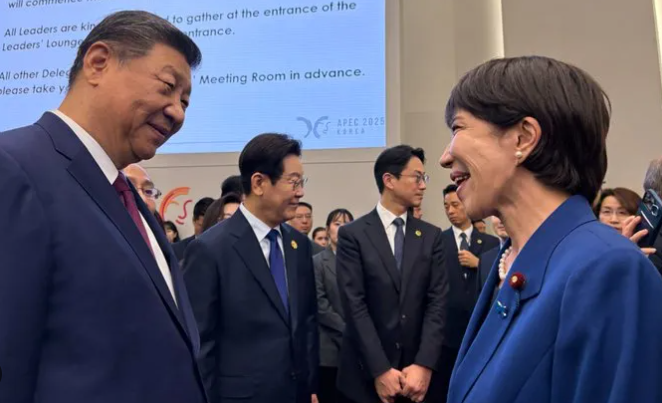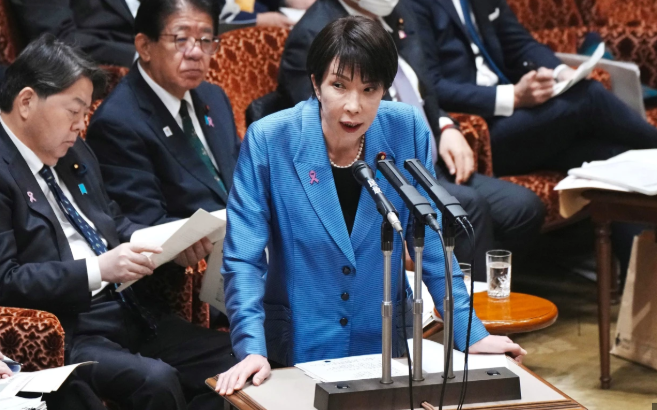Tokyo and Beijing on a Collision Course: Is Takayichi Leading Japan to War?

Mehr News Agency, International Desk: Last week, Japan witnessed a controversial stance that may be remembered as a turning point in East Asian relations years from now. San’ae Takayichi, Japan’s newly appointed and enterprising prime minister, declared openly in parliament that any Chinese attack on Taiwan could represent an “existential threat to Japan.” This statement marked the first time such words came from a sitting Japanese leader and quickly ignited tensions like a spark in Beijing’s powder keg.
Across the taiwan Strait, china’s reaction was not only harsh but unusually brash. Beijing promptly summoned the Japanese ambassador,issued angry military statements,and saw its Consul-General in Osaka post-and later delete-a provocative message threatening that “a dirty neck that sticks itself inside must be cut off.”
This political eruption came exactly one month after Takayichi’s pleasant and smiling meeting with Xi Jinping on the sidelines of the Asia-Pacific Economic Cooperation (APEC) summit. That meeting had been expected to thaw relations but today only highlights how smiles and ceremonial talks cannot melt the deep freeze between China and Japan.
The current tensions stem from layers of ancient mistrust, geopolitical rivalry, and security calculations growing more complex each day.
Historical Roots of Sino-Japanese Tensions
The ongoing friction between China and Japan cannot be understood without grasping their painful shared history. World War II leaves long shadows over their relationship. The Nanjing Massacre-were Imperial Japanese forces killed over 200,000 civilians and subjected tens of thousands of women to rape and torture-is one of the most infamous war crimes of the 20th century.
These historical wounds remain largely unhealed. In the 21st century, right-wing Japanese politicians have often denied wartime atrocities during the Second Sino-Japanese war. China-alongside other Asian nations like South Korea-has condemned Japanese history textbooks for downplaying these crimes.
Beyond historical memory lies another tangible flashpoint: sovereignty disputes over the Senkaku islands (referred to as Diaoyu Islands by China). This cluster includes five uninhabited islands and three reefs annexed by Japan in 1895; both China and Taiwan claim sovereignty over them. The discovery in 1968 of potential offshore oil reserves intensified interest in these disputed territories.
In 2012, when Tokyo purchased three islands from private owners’ hands-a move sparking widespread protests across China and taiwan-the dispute escalated further. As then, chinese coast guard vessels have regularly entered waters around these islands. In 2013 Beijing declared an Air Defense Identification Zone including Senkaku/Diaoyu Islands.
Tensions Escalate under Takayichi’s Short Tenure
Takayichi became Japan’s first female prime minister last month but radically shifted political discourse with her November 7 remarks about Taiwan – signaling that collective self-defense might apply should an attack occur there.
Even though late Shinzo Abe held similar views after leaving office as her mentor politically did previously express comparable sentiments post-retirement – this is the first time a sitting prime minister has explicitly made such declarations under specific scenarios involving Taiwan.
This marks departure from decades-long strategic ambiguity maintained by Tokyo regarding its stance toward Taiwan.
Beijing responded immediately with unprecedented aggression: The people’s Liberation Army newspaper ran front-page editorials expressing outrage at her comments while People’s Daily – official Communist party mouthpiece – accused Takayichi of “reckless boasting”, warning no one should underestimate China’s red line concerning Taiwan without paying severe consequences.
That Friday also saw travel warnings issued against visiting or studying in Japan citing recent provocative statements about Taiwan have harmed people-to-people exchanges and increased risks for Chinese citizens living there.
Despite intense backlash from Beijing forcing many international leaders into cautious language revisions-Takayichi refused retractions implying readiness for potential armed intervention near Taiwanese waters.
Her hawkish position drew domestic criticism too: several lawmakers including former Prime Ministers Yukio Hatoyama and Shigeru ishiba urged her publicly revoke those remarks.The Impact on Bilateral Relations & Regional Stability
Current strains considerably affect economic ties between both nations which stood at $292.6 billion USD trade volume last year alone (2024). As 2005 China’s been Tokyo’s largest trading partner even though growing friction threatens this vital economic linkage drastically.
The diplomatic row now extends beyond politics reaching into economy where Beijing advises citizens against travel or studies abroad amid instability fears - some six Chinese airlines offer refunds or free ticket changes until end December amid reduced demand.
Over 100 thousand mainland students currently study throughout Japanese universities while roughly 25% share tourism stemming annually reflects notable blows sustained by retail & hospitality stocks here.
Economic experts warn if tourism recedes similarly as seen during irritation spike back circa-2012 (~25% fall), significant losses threaten national revenue streams.
Analysts caution escalation toward trade wars holds particular peril relating rare earth mineral exports-which underpin crucial sectors ranging electronics manufacturing primarily autos confronting surging competition especially electric vehicles produced domestically within China markets).
Asian stock exchanges also felt immediate effects: On Monday regional share prices mostly declined even though U.S futures showed modest increases overall.
Japan’s Nikkei index dipped following news reporting Q3 GDP slowing sharply (-1 .8%), fueling investor unease amid mounting Sino-Japanese geopolitical strains impacting capital trust negatively,
while Hong Kong’s Hang Seng dropped approx .7% settling near level ~26 ,384 points alongside Shanghai Composite falling ~0 .5%,closing close approx .3 ,972 units respectively
Militarily heightened alert follows too with Sunday announcements revealing PLA Coast Guard patrols out surrounding contested Senkaku/Diaoyu archipelago occurring amid rising unease connected directly with recent explosive remarks around Taipei targets flagged regionally.
Crucially this crisis surpasses bilateral concerns alone given Taiwanese political figures public opinion leaders condemning what they deem reckless provocations undermining peaceful intentions critical therein:
former Kuomintang chairman Ma Ying-jeou voiced worry stating rhetoric echoes resurgence conservative militarist tendencies reminiscent historic prewar J apanese nationalism persisting troublingly presently affecting security calculus integral cross-strait balance maintained till now
The United States’ Role & Power Dynamics Across east Asia
Takayichis’ stance intersects fundamentally along existing frameworks built upon US-Japan Security Treaty plus Washington’s strategizing tailored regionally-
Notably allies aim extending defensive reach covering additional domains inclusive space wavefront intersecting satellite intercept capabilities integrated across evolving early-warning networks.
Article Six provisions empower American usage bases/facilities spanning mainland archipelago operating peace/security preservation efforts throughout far Eastern theater including silent backing enabling indirect Taiwanese defense support continuing some six decades running so far according multiple sources acquainted intimately
US seeks allied coordination counterbalancing perceived threats organizing distributed military resources worldwide amidst expanding range challenges thus relying heavily maintaining influence leveraging proximity offered via joint host-nation agreements
Survey data reveals approximately barely fifteen percent public support willingness fighting alongside U.S forces defending Taipei territory contrasting extensive eighty-to ninety percent consistently viewing PRC unfavorably trends reflect substantive national alignment poised serving deterrence objectives diplomatically aligned partly approximating popular mood backing greater assertiveness overall inside domestic policymaking spheres involved directly
trump administration prioritizes denial deterrence specific modality aiming thwart PR campaign designs directed forced TC incursion efforts avoiding loss sets catastrophic outcomes per Pentagon policy official Elbridge Colby referring Senate hearing testimony confirming losing island group constitutes disaster wiping out salient US vital interests distinctly contrasting punitive deterrence relying economic sanctions signaling ongoing complexity multidimensional engagement necessary calibrating risk factor levels precisely calibrated semi-official favor official dialogue selectively restrictive force deployment sharing among western allied components collectively reassuring>
Without access allowing functioning airpower projection quickly deployable operational assets reliant upon infrastructures positioned strategically throughout mainland archipelago states would prove exceedingly constrained
hence criticality placed squarely valuing credibility integration distinctively elevates Tokyo viewpoint influential Washington positioning indirectly necessitating tacit endorsement firm messaging strengthening resolve purely strategic manner enjoyed hitherto reportedly supporting hardened posture advocated visibly meanwhile refl ecting complicated balancing act inherent broader alliance survival sustainability guarantees prominent determinants shaping trajectory evolving standoff dynamics hereafter
Nevertheless growing peril remains contained worst-case scenarios simultaneously igniting crises Korean Peninsula/taiwan meeting possibly catalyzing high stakes multilateral conflict involving global power framework insupportable spiral eruptive ecological system disastrous ripple effects destabilizing beyond localized theatres affecting wider Pacific realms substantially-
Navigating increasingly multipolar world throughout next calendar year demands deft orchestration maneuvering dispersed strain linked US-China frictions diversification priorities bolstered regional security agendas balancing contingency fallout deeper rupturing intertwined foundations severely eroding favorable export markets constituting backbone commercial shipments underpinning medical automotive electronic giant industries
A Final Word
The present crisis stirred acutely by San’ae Takayichis hardline speeches builds atop deeply-rooted historic grievances compounded geopolitical rivalries shifting power equations reshaping regional landscape sequentially accelerating fractures dividing once cooperative chapters
Now emboldened uncompromising premier widens rift vastly exposing decades forged gains intangible economy diplomacy stark jeopardy looming critically jeopardizes fabric order accumulated deliberately notwithstanding
Meanwhile America plays dual roles steadfast ally fortifying essential interests opposing development foremost adversary influencing direction either bolstering outright tough policies supporting increasingly persistent partners elsewhere pushing combined pressure orchestrated dial-back dialogic engagements striving manage turbulence unfolding unpredictably
Ultimately future trajectory connecting China-Japan relations, stretching beyond encompassing East Asia stability hinges crucially political leadership ability reigning diplomatic skill mastering complexities preserving paths ending avoidance costly confrontation imposing transnational ramifications transcending boundaries well outside proximate territories directly interwoven already exposed vulnerable affected societies globally alike






